2017 Volvo S90 Review: Living the (Nearly) Self-Driving Life
Our Verdict
For those concerned nigh safety, the latest and greatest avant-garde commuter aid systems come standard in Volvo's impressive new S90 sedan.
For
- Advanced safety systems are standard on all models
- Luxurious appointments
- Svelte pattern
- Solid connected car organization
Against
- Machine airplane pilot non ready to accept over, yet
- Android Auto support nevertheless to come
- Weak spoken communication recognition
Tom'southward Guide Verdict
For those concerned about prophylactic, the latest and greatest advanced driver assistance systems come standard in Volvo'southward impressive new S90 sedan.
Pros
- +
Advanced rubber systems are standard on all models
- +
Luxurious appointments
- +
Svelte pattern
- +
Solid connected auto organisation
Cons
- -
Auto airplane pilot not ready to take over, yet
- -
Android Car support still to come
- -
Weak spoken communication recognition
With warning bells ringing in my ears and the Volvo S90 perched precariously on the edge of a cliff, it occurred to me that the auto's engineers probably didn't envision their luxury sedan packed total of condom features would exist gingerly shepherded down what amounted to a mountain goat path in Spain. But the unintended off-road experience--plus hours of easily on (and easily-off) driving--proved that the technologically tricked out S90 is more than but a pretty face. It's also the first machine to come standard with an array of semi-autonomous driving features.
The 2017 Volvo S90 is the second model from the automaker, following the XC90 SUV, that's based on a new technology platform and features Volvo's touch-screen based connected car organisation. Volvo has upped the rubber and self-driving features on the sedan, adding large creature detection and taking the initial Pilot Assist version from city-only driving up to 80 mph highway speeds. It works well compared to similar systems from other automakers, only in that location'due south a learning bend for drivers anxious to adopt the latest technology.
Suite Tech: Near Autonomous
A myriad of safe and advanced driver help (ADS) systems are baked into the 2017 S90 every bit standard equipment. It includes route edge detection that monitors the shoulder and gently tugs the bike dorsum into the lane to forbid dangerous wheels-off-road rollovers (that's the system pinging me on the mountain path).
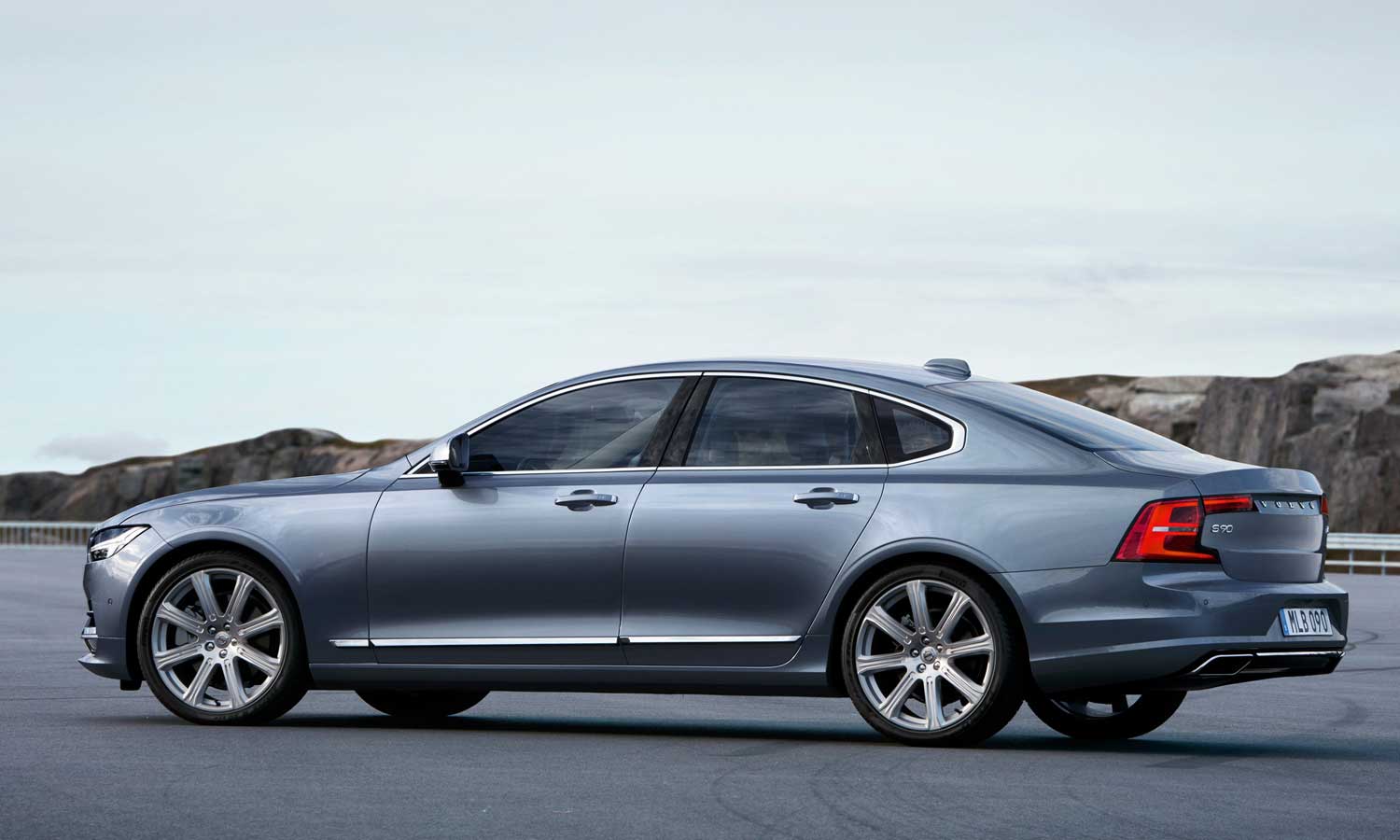
To its pedestrian and cyclist collision avoidance systems, Volvo has added large animal detection that uses radar to sense obstacles alee and a video camera to identify deer and moose. A alert low-cal and chinkle will sound should you run into such a threat and then if you don't apply the brakes, the automobile will exercise information technology for you. (As a sit-in that cars are increasingly rolling computers, Volvo will also do a software upgrade of its 2016 XC90 to add the large animal detection feature.) According to a 2012 State Farm study, there are about ane.23 million deer-car accidents a year, so any technology that tin help mitigate such accidents is welcome.
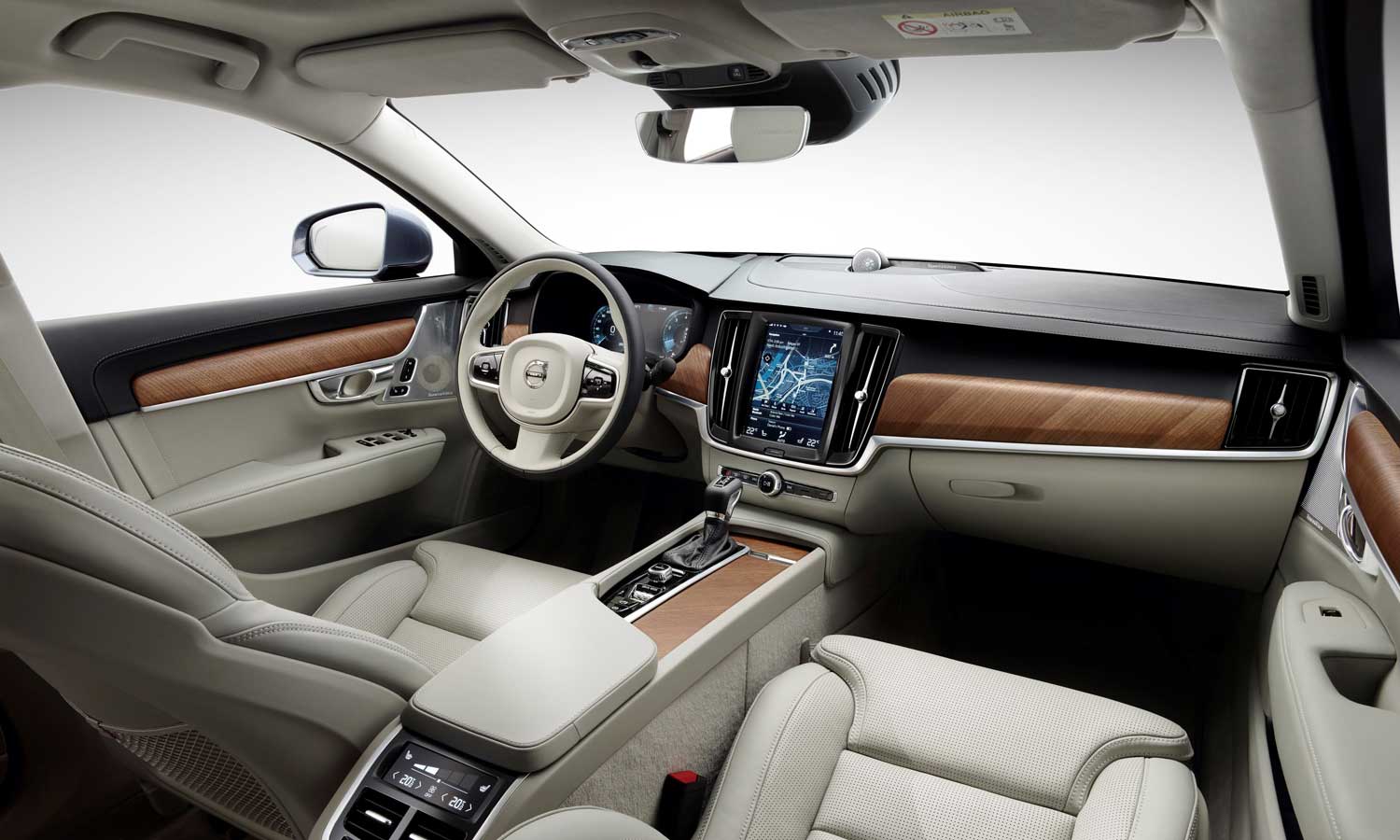
The applied science alluring the most attention in the S90, however, is the company's latest semi-democratic Pilot Aid arrangement. It has been upgraded so that it at present works to a higher place 30 mph up to about 80 mph and it no longer relies on post-obit a automobile in front end of you. The new Pilot Assist will maintain your speed and follow lane markings, steering the machine for you every bit long as your manus rests lightly on the wheel.

On the highway, the Pilot Assist system worked well most of the time. In one case you've set the speed and turned it on by pushing a push button on the left-manus portion of the steering wheel, a greenish steering bike icon lights up in the center stack on the caput-up display to tell you it's on. You can accept your hands off the cycle for up to 16 seconds before a bulletin flashes on the dash to take the wheel once again. If you don't, you'll hear more alarm chimes and so the automatic arrangement disengages. The system is also smart enough to temporarily switch off when you bespeak to change lanes and and so plow dorsum on when you complete the lane alter; information technology worked flawlessly in such situations for me (it could even train drivers to signal for a change).
The new Pilot Assist organization will maintain your speed to up to 80 mph and steer the auto for you every bit long every bit your mitt rests lightly on the wheel.
Volvo emphasizes that the Pilot Assist feature is not intended for YouTube showboating: It's a driver support system--yous're withal captain of the ship. At that place's a good reason for that: the system is non perfect. On quick, curvy mount roads, the Pilot Assistance sometimes failed to "see" an upcoming corner in time. It also takes time to get accustomed to the steering feel. If you put the car into "condolement" driving mode (for a more costly, effortless highway drive), in that location's a distinctive tightening of the bicycle every time the automobile makes a lane-centering adjustment. On the other hand, the steering tweaks are less noticeable if you set the car into "dynamic" way.
Furthermore, some drivers won't appreciate the way the auto will continually force the vehicle squarely into the center of the lane if they're more than comfortable either hugging the yellow line or skirting the right white line.
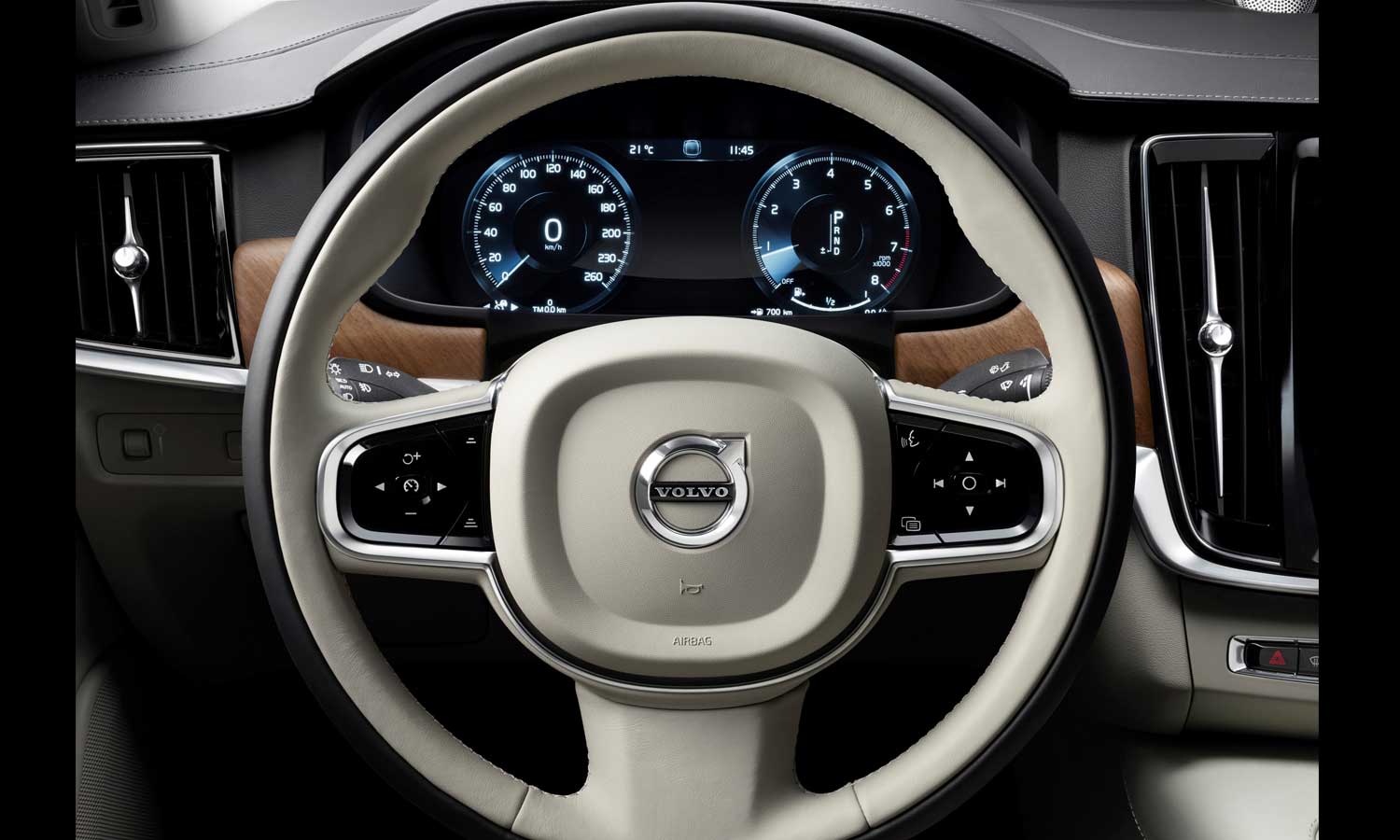
Yous can go conceited with Pilot Assistance, and then you're suddenly reminded that human driver input is essential. As I came around a slight curve on a two-lane highway, the S90 gently steered me abroad from the correct hand soft shoulder at precisely the moment a car coming the reverse mode veered into my lane to avoid a cyclist on his side. I quickly directed the car back toward the right side to avert a collision. If I had not washed so, the Pilot Help would not accept reacted in time.
While the Volvo engineers take overcome flaws I've witnessed in competing vehicles, such as being fooled by dark shadows or pole reflectors on curves, non everything was seamless in the S90.
More than: Connected Cars: A Guide to New Vehicle Technology
On two days of test driving, I encountered several tunnels with the car in Pilot Assist mode. Sudden lights and shadows did not fool the S90, but near the end of ane particularly long tunnel, the emergency braking kicked on for a split 2nd and so off before I could utilise the accelerator to disengage the system. Information technology should have likewise have automatically turned off the Airplane pilot Help but it didn't. The glitch did not present whatever danger, but the hiccup was a sit-in that no software programme or computer is admittedly flawless.
Tablet In the Nuance: Connecting the Dots
Volvo's Sensus impact-screen based connected auto organisation fabricated its debut in the XC90 final year. The big 9-inch vertically mounted screen uses infrared sensors, so that it can be used with gloves, and information technology reacts quickly and smoothly. It'southward based on a four-tile interface with navigation, media (radio and music), phone, and apps.
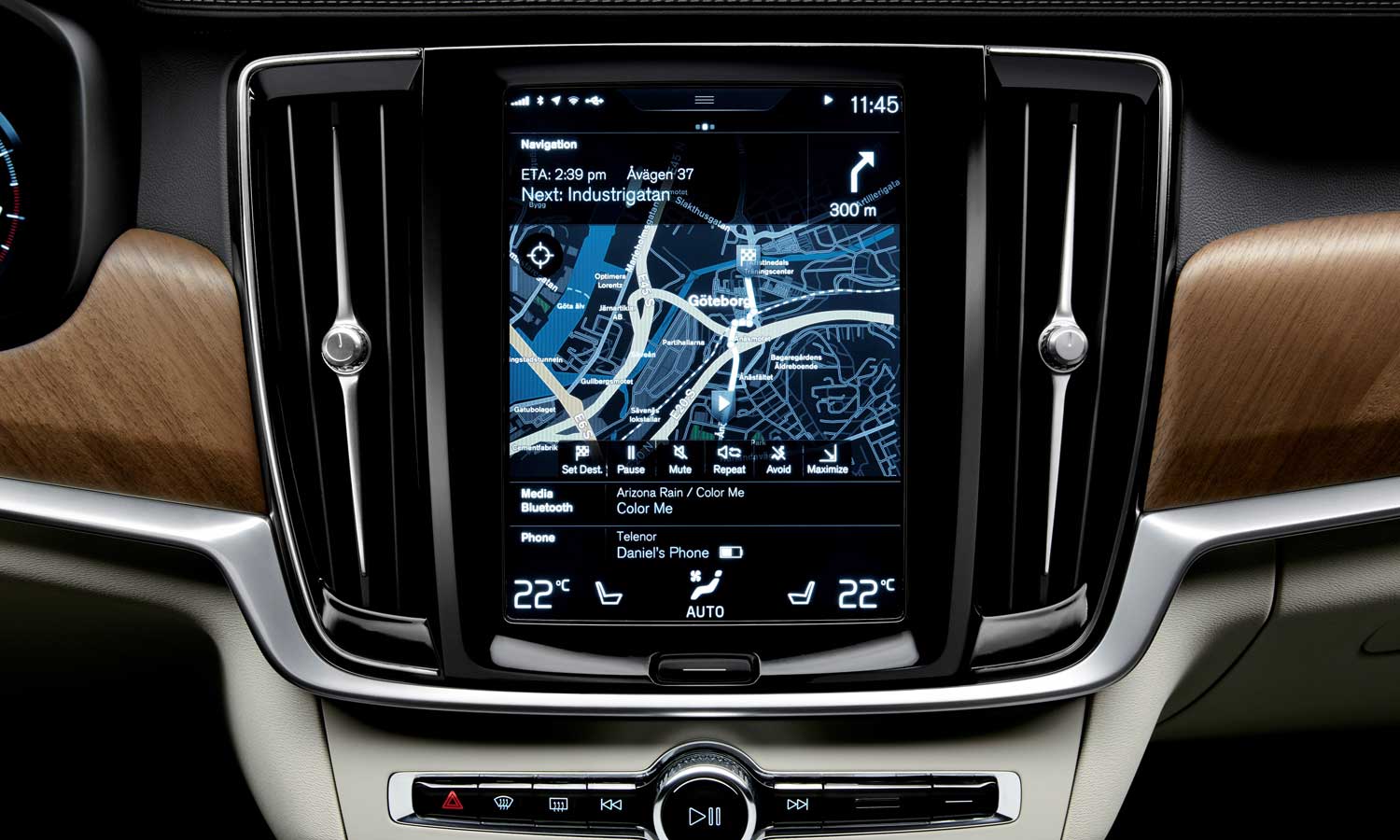
One nifty trick is that the car supports Spotify without the need for a connected smartphone. The system likewise works with Apple tree's CarPlay and uniquely does not have to give up the whole screen to Apple tree's uber app. This is a major advantage over other CarPlay implementations because information technology means you have the residual of the screen to admission features such equally temperature command and ADS functions, which cannot be controlled from inside CarPlay.
I found the Volvo interface logical and easy to master. Swipes left and right invoke unlike screens with various detailed adjustments covering everything from adaptive prowl control to flexible seat bolsters. You lot tin also input an address using an on-screen keyboard or draw letters on the screen (remember the Palm Airplane pilot?).
One nifty fob is that the S90 supports Spotify without the demand for a connected smartphone.
Volvo has likewise added Wi-Fi based on 4G LTE support so the whole family can bask the wireless connection. Topping it all off, there are but plenty physical buttons and steering bike controls then that yous don't have to accomplish for the screen if yous don't want to.
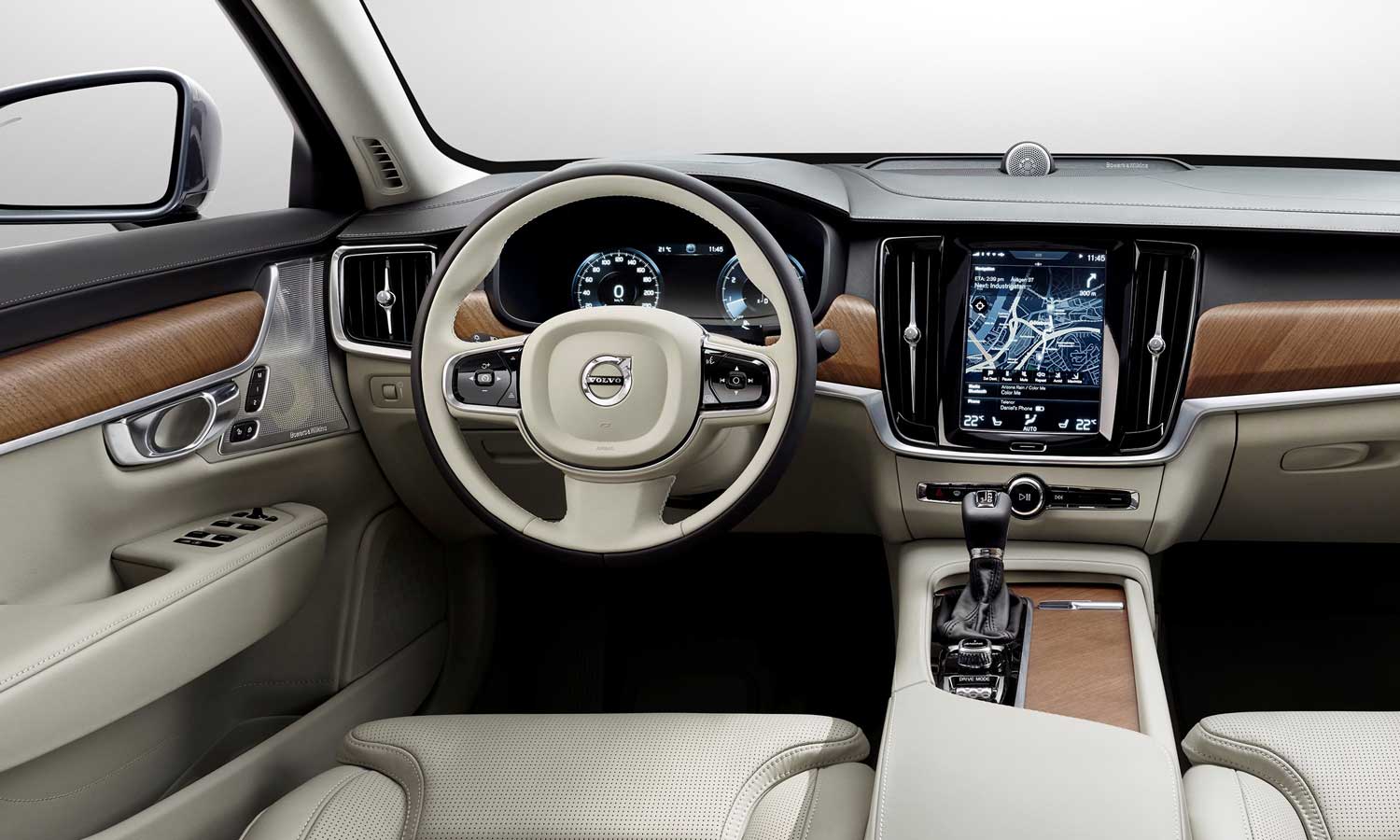
Alas, the Sensus' bette noire is the spoken language recognition component. Information technology uses a limited lexicon of words, rather than understanding natural language instructions. So it works reasonably well handling navigation commands or music requests, but it does not understand requests to change the AC or switch driving modes. (Siri can't help you with those tasks either, because Apple's assistant is limited to infotainment functions.)
The navigation organization worked well--with the one off-road, cliff-hanging exception--and responded quickly when nosotros missed a plough at a traffic circle. I particularly appreciated the head-up color display that showed speed, direction and icons telling me when various driver assistance programs were engaged.
MORE: Apple CarPlay FAQ: Everything You Demand to Know
Just Drive It: Luxury Four-Door
On my piffling clay path excursion into Spaghetti Western territory, the all-wheel drive system in the T6 model was a welcome feature. The S90 climbed steep embankments like a sprightly cantankerous over, and negotiated the ruts and rocks with aplomb. So if you face snowy winters, the Volvo should give you added conviction. Simply the S90 is really built for cruising.
The new S90's sinuous lines are a refinement of an evolving design, and while the company refers to details like the front end running lights every bit invoking Thor, I found the front more feline than hammer of the gods. And then also with the driving feel. Highway handling was shine and relaxed.
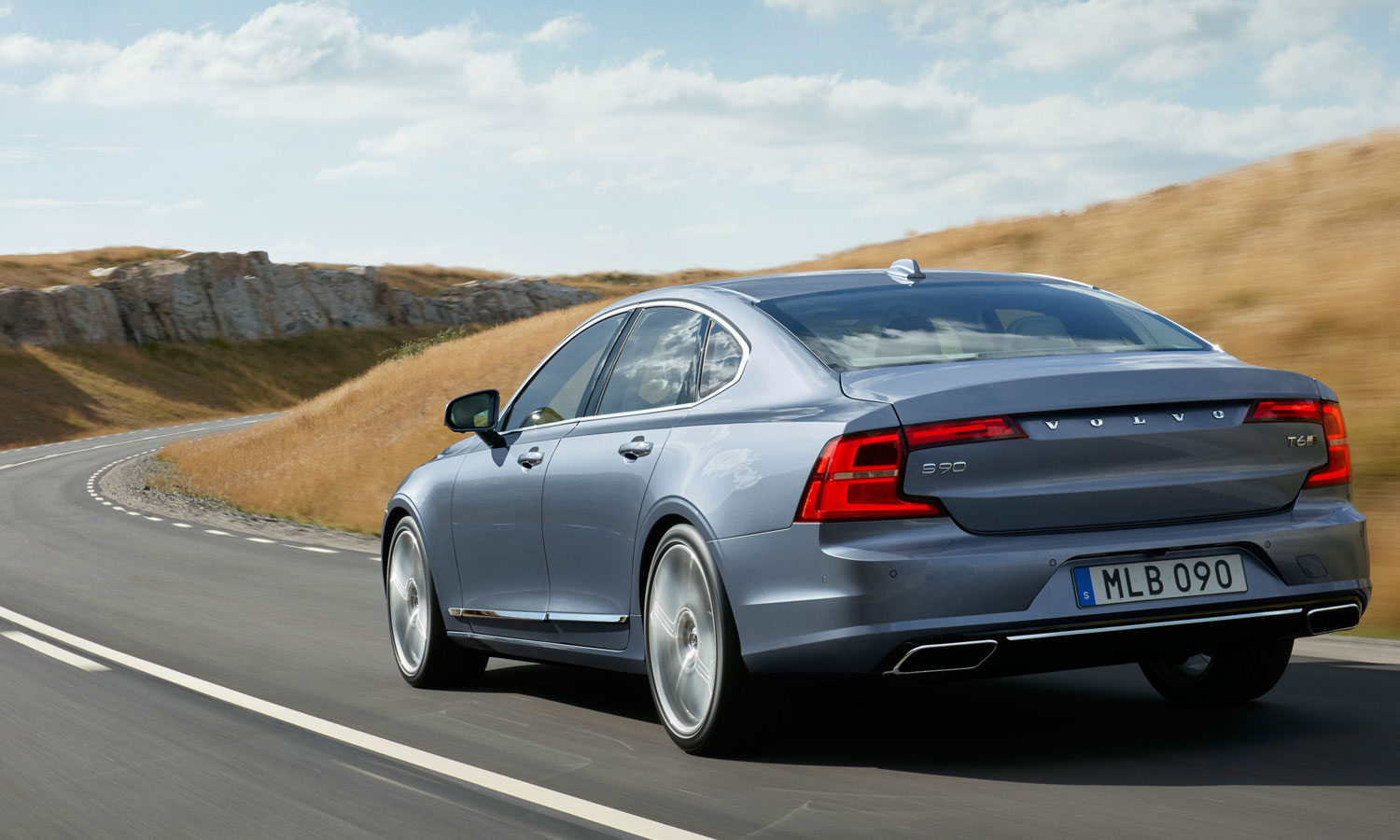
The combination of turbo and supercharging the 4-cyclinder, 316-hp engine means you're not defective for power in the low end when trying to merge, and still you've however got plenty of a boost at higher speeds when y'all need to pass. The model I drove was rated to get you from 0 to sixty mph in 5.seven seconds; non the quickest in its class but as well non terribly tardy.
Whether you're trying to save gas, cruise in condolement or snap the car through land curves, there'southward a preset driving style for your mood. Condolement mode, for example, loosens the steering to brand it more forgiving while dynamic mode is best for backroads. Y'all can too customize the suspension, shifting and steering for your own individual preferences. But whatever setting y'all cull, you'll find the car predictable and responsive, adhering to Volvo's philosophy that there should exist "no surprises" when it comes to driving.
With all the driver assist technologies engaged, I found the S90 subtle in terms of communicating to me what was happening. If I strayed too close to the shoulder a steering vibration permit me know I was stepping on the white line--without alerting the passengers as well. In general, such warnings as proximity alerts and chimes were obvious and understandable.
More than: Android Auto FAQ: Everything Y'all Need to Know
The one change that took me several hours to get used to was the fact that the Pilot Assist can plough off when you lot may not expect it; if yous get too condescending on a twisty highway with poorly demarcated lines, the organisation will turn off and starting time to drift before the driver notices. The more miles backside the wheel, the more I became accustomed to the paw-offs, only it'southward an result facing every automaker with semi-autonomous designs.
Bottom Line
On the path to making automobiles safer and saving lives, the 2017 Volvo S90 is a milestone because it establishes advanced safety engineering as standard equipment. Other automakers, by contrast, accept merely promised to brand automatic emergency braking standard by 2022. Furthermore, pedestrian detection and the large animal detection systems work both twenty-four hour period and night, providing another level of driver help.
Compared to others in its class, such equally the BMW 5 Series or Audi A6, the new Volvo S90 is a serious contender, especially for those who are serious about safety. While the semi-autonomous systems aren't perfect, they still can save a driver from a disastrous mistake, something whatever family or couple looking at a sedan should capeesh.
2017 Volvo S90 T6 Inscription: The Vitals
Cost as Tested: $57,245 MSRP (including destination charge)
Engine and Drive train: ii.0-liter, supercharged and turbocharged four-cylinder engine with eight-speed automatic transmission and all-wheel bulldoze.
Fuel Rating: Northward/A.
Continued Car Arrangement: Volvo Sensus with 9-inch touch screen.
Safety Technologies: Collision avoidance with pedestrian, cyclist and large animal detection; lane departure warning, border mitigation, adaptive cruise control with machine stop and go.
Driver Assist Technologies: Lane keeping (Pilot Assist), parking help, 360 degree photographic camera view, rear-view camera.
Installed Options: Rear cross traffic alert, bending headlights.
Source: https://www.tomsguide.com/us/2017-volvo-s90,review-3726.html
Posted by: souzasaime1973.blogspot.com


0 Response to "2017 Volvo S90 Review: Living the (Nearly) Self-Driving Life"
Post a Comment